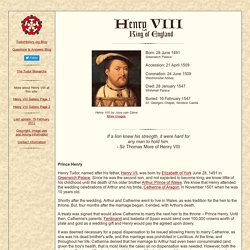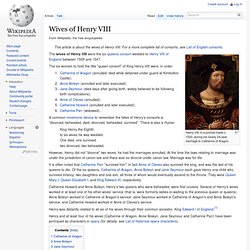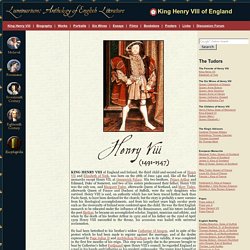

Henry VIII. Henry VIII, born in 1491, was the second son of Henry VII and Elizabeth of York. The significance of Henry's reign is, at times, overshadowed by his six marriages: dispensing with these forthwith enables a deeper search into the major themes of the reign. He married Catherine of Aragon (widow of his brother, Arthur) in 1509, divorcing her in 1533; the union produced one daughter, Mary. Henry married the pregnant Anne Boleyn in 1533; she gave him another daughter, Elizabeth, but was executed for infidelity (a treasonous charge in the king's consort) in May 1536. He married Jane Seymour by the end of the same month, who died giving birth to Henry's lone male heir, Edward, in October 1536. Early in 1540, Henry arranged a marriage with Anne of Cleves, after viewing Hans Holbein's beautiful portrait of the German princess.
Henry VIII of England. Henry VIII (28 June 1491 – 28 January 1547) was King of England from 21 April 1509 until his death.

He was Lord, and later assumed the Kingship, of Ireland, and continued the nominal claim by English monarchs to the Kingdom of France. Henry was the second monarch of the Tudor dynasty, succeeding his father, Henry VII. Besides his six marriages, Henry VIII is known for his role in the separation of the Church of England from the Roman Catholic Church. The Tudors > Henry VIII. Henry VIII was born at Greenwich on 28 June 1491, the second son of Henry VII and Elizabeth of York.

He became heir to the throne on the death of his elder brother, Prince Arthur, in 1502 and succeeded in 1509. In his youth he was athletic and highly intelligent. A contemporary observer described him thus: 'he speaks good French, Latin and Spanish; is very religious; heard three masses daily when he hunted ... He is extremely fond of hunting, and never takes that diversion without tiring eight or ten horses ... He is also fond of tennis.' Henry's scholarly interests included writing both books and music, and he was a lavish patron of the arts. He was an accomplished player of many instruments and a composer. As the author of a best-selling book (it went through some 20 editions in England and Europe) attacking Martin Luther and supporting the Roman Catholic church, in 1521 Henry was given the title 'Defender of the Faith' by the Pope.
None produced any children. Henry VIII. If a lion knew his strength, it were hard for any man to hold him. - Sir Thomas More of Henry VIII.

Henry VIII. Wives of Henry VIII. Henry VIII, in a portrait made c. 1520, during his nearly 24-year marriage to Catherine of Aragon.

The wives of Henry VIII were the six queens consort wedded to Henry VIII of England between 1509 and 1547. The six women to hold the title "queen consort" of King Henry VIII were, in order: Catherine of Aragon (annulled; died while detained under guard at Kimbolton Castle);Anne Boleyn (annulled and later executed);Jane Seymour (died days after giving birth, widely believed to be following birth complications);Anne of Cleves (annulled);Catherine Howard (annulled and later executed);Catherine Parr (widowed). A common mnemonic device to remember the fates of Henry's consorts is “divorced, beheaded, died, divorced, beheaded, survived”.
There is also a rhyme: King Henry VIII (1491-1547) The Life of King Henry VIII (1491-1547). Biography of Henry Tudor, King of England. KING HENRY VIII of England and Ireland, the third child and second son of Henry VII and Elizabeth of York, was born on the 28th of June 1491 and, like all the Tudor monarchs except Henry VII, at Greenwich Palace.

His two brothers, Prince Arthur and Edmund, Duke of Somerset, and two of his sisters predeceased their father; Henry VIII was the only son, and Margaret Tudor, afterwards Queen of Scotland, and Mary Tudor, afterwards Queen of France and Duchess of Suffolk, were the only daughters who survived. Henry VIII is said, on authority which has not been traced farther back than Paolo Sarpi, to have been destined for the church; but the story is probably a mere surmise from his theological accomplishments, and from his earliest years high secular posts such as the viceroyalty of Ireland were conferred upon the child.
Ferdinand died in that year (1516) and the emperor Maximilian in 1519. Nevertheless their rising warned Henry VIII against further doctrinal change. (A. Excerpted from: History - Historic Figures: Henry VIII (1491 - 1547) The Six Wives of Henry VIII.